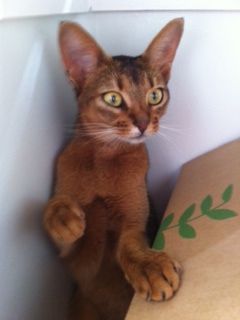The Abyssinian is one of the oldest domestic breeds. It is believed by many people that the Abyssinian is descended from the cats of ancient Egypt and, indeed, they do bear a strong resemblance to the cats depicted by sculptures and paintings found in the Egyptian pyramids.
The precise origins of the Abyssinian remains unclear, although it is fairly certain that the wife of an English Army officer, a Mrs Captain Barrett-Leonard, brought the original specimen back to Britain from Abyssinia in 1868. Other members of the army may have also brought these cats back from what is now known as Ethiopia around this time. It is known that the first mention in a book was in 1874, the breed was recognized in Britain in 1882.
In Australia, the first Abyssinians were imported during the late 1950's from England and New Zealand.
Abyssinians are medium-sized cats. They are very elegant, regal-looking
cats with strong, fleixible bodies and long, slender legs. Their paws are
small and oval. They have round, wedge-shaped heads with distinctive
tuffed tips to the ears which are large and pointed and set wide apart.
Their eyes are large and almond-shaped and they have short, close-lying
coats. Their tails are fairly long, broad
at the base and tapering to a point. Abyssinians comes in a range of different colors, Ruddy being the most common coat color. They are also seen in sorrel, blue or fawn colors. Silver Abyssinians are a
separate group which includes black silver, blue silver, fawn silver
and sorrel silver. Not so common colors are tortoiseshell, red, cream,
chocolate and lilac. The Abyssinian's coat does little shedding and is relatively easy to care for with a brush and comb through occasionally.
The Abyssinian is intelligent and curious, but this is tempered with a cautious streak.They are extremely loyal, and will become very attached to there family. The male will generally tolerate other cats well, but the female may be a little prickly and prefer to be the only cat in the family. Both sexes can form strong attachments to dogs.
The worst thing that you can do to
an Abyssinian is deprive it of human company, and it is important that
it lives in a household where people are usually at home. It also hates
being confined, and needs plenty of space. It is a good climber. This cat is not
much of a talker, but will still let its owner know exactly what it
wants.It is playful and inquisitive but also sensible and will not rush
into situations recklessly. After a game it will be happiest sitting on its
owners lap being stroked and petted.
The Abyssinian Cat Club of Australia's website is http://www.abyssinian.org.au
* Information was gathered from several websites such as www.abyssinian.com.au, www.abyssinian.org.au, www.purina.com.au
The precise origins of the Abyssinian remains unclear, although it is fairly certain that the wife of an English Army officer, a Mrs Captain Barrett-Leonard, brought the original specimen back to Britain from Abyssinia in 1868. Other members of the army may have also brought these cats back from what is now known as Ethiopia around this time. It is known that the first mention in a book was in 1874, the breed was recognized in Britain in 1882.
In Australia, the first Abyssinians were imported during the late 1950's from England and New Zealand.
 | ||||
| Photo of the first litter born in 1960 in NSW. |
The first five Abyssinians to arrive in NSW came early
in 1959. 'Finisterre Casim' a male and 'Finisterre Sherada' a female, were
from New Zealand. They were consigned to Mrs J Thurmer of South
Australia, but due to some problem, were collected and held in Sydney
for several weeks before continuing to Adelaide.
Despite their wanderings when they settled with Mrs
Thurmer they proved to be a good breeding pair and produced the first
registered Abyssinian litter in Australia (they were later sold to a
Victorian breeder, and continued to produce prolifically).
 |
| Isis |
The Abyssinian is intelligent and curious, but this is tempered with a cautious streak.They are extremely loyal, and will become very attached to there family. The male will generally tolerate other cats well, but the female may be a little prickly and prefer to be the only cat in the family. Both sexes can form strong attachments to dogs.
 |
| Isis |
The Abyssinian Cat Club of Australia's website is http://www.abyssinian.org.au
 |
| Felix |
* Information was gathered from several websites such as www.abyssinian.com.au, www.abyssinian.org.au, www.purina.com.au
No comments:
Post a Comment